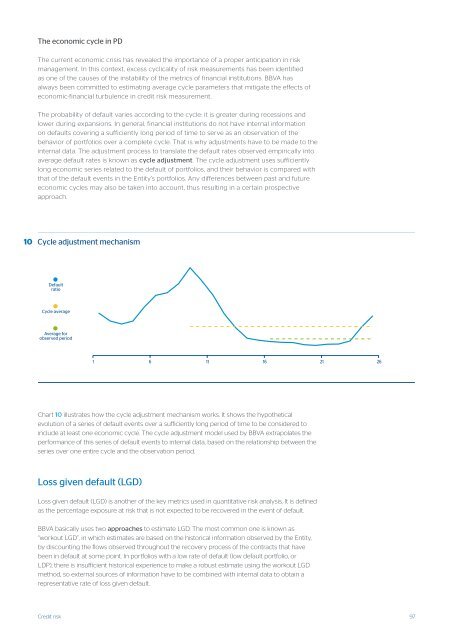BBVA in 2012
BBVA in 2012
BBVA in 2012
Create successful ePaper yourself
Turn your PDF publications into a flip-book with our unique Google optimized e-Paper software.
The economic cycle <strong>in</strong> PDThe current economic crisis has revealed the importance of a proper anticipation <strong>in</strong> riskmanagement. In this context, excess cyclicality of risk measurements has been identifiedas one of the causes of the <strong>in</strong>stability of the metrics of f<strong>in</strong>ancial <strong>in</strong>stitutions. <strong>BBVA</strong> hasalways been committed to estimat<strong>in</strong>g average cycle parameters that mitigate the effects ofeconomic-f<strong>in</strong>ancial turbulence <strong>in</strong> credit risk measurement.The probability of default varies accord<strong>in</strong>g to the cycle: it is greater dur<strong>in</strong>g recessions andlower dur<strong>in</strong>g expansions. In general, f<strong>in</strong>ancial <strong>in</strong>stitutions do not have <strong>in</strong>ternal <strong>in</strong>formationon defaults cover<strong>in</strong>g a sufficiently long period of time to serve as an observation of thebehavior of portfolios over a complete cycle. That is why adjustments have to be made to the<strong>in</strong>ternal data. The adjustment process to translate the default rates observed empirically <strong>in</strong>toaverage default rates is known as cycle adjustment. The cycle adjustment uses sufficientlylong economic series related to the default of portfolios, and their behavior is compared withthat of the default events <strong>in</strong> the Entity’s portfolios. Any differences between past and futureeconomic cycles may also be taken <strong>in</strong>to account, thus result<strong>in</strong>g <strong>in</strong> a certa<strong>in</strong> prospectiveapproach.10Cycle adjustment mechanismDefaultratioCycle averageAverage forobserved period1 6 11 16 21 26Chart 10 illustrates how the cycle adjustment mechanism works. It shows the hypotheticalevolution of a series of default events over a sufficiently long period of time to be considered to<strong>in</strong>clude at least one economic cycle. The cycle adjustment model used by <strong>BBVA</strong> extrapolates theperformance of this series of default events to <strong>in</strong>ternal data, based on the relationship between theseries over one entire cycle and the observation period.Loss given default (LGD)Loss given default (LGD) is another of the key metrics used <strong>in</strong> quantitative risk analysis. It is def<strong>in</strong>edas the percentage exposure at risk that is not expected to be recovered <strong>in</strong> the event of default.<strong>BBVA</strong> basically uses two approaches to estimate LGD. The most common one is known as“workout LGD”, <strong>in</strong> which estimates are based on the historical <strong>in</strong>formation observed by the Entity,by discount<strong>in</strong>g the flows observed throughout the recovery process of the contracts that havebeen <strong>in</strong> default at some po<strong>in</strong>t. In portfolios with a low rate of default (low default portfolio, orLDP), there is <strong>in</strong>sufficient historical experience to make a robust estimate us<strong>in</strong>g the workout LGDmethod, so external sources of <strong>in</strong>formation have to be comb<strong>in</strong>ed with <strong>in</strong>ternal data to obta<strong>in</strong> arepresentative rate of loss given default.Credit risk97
















